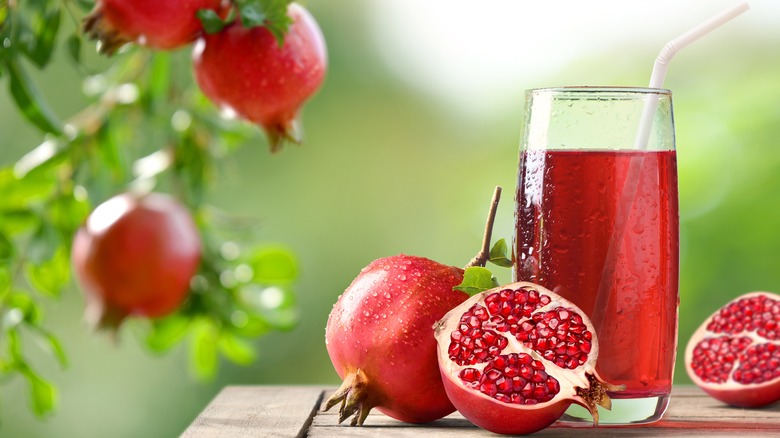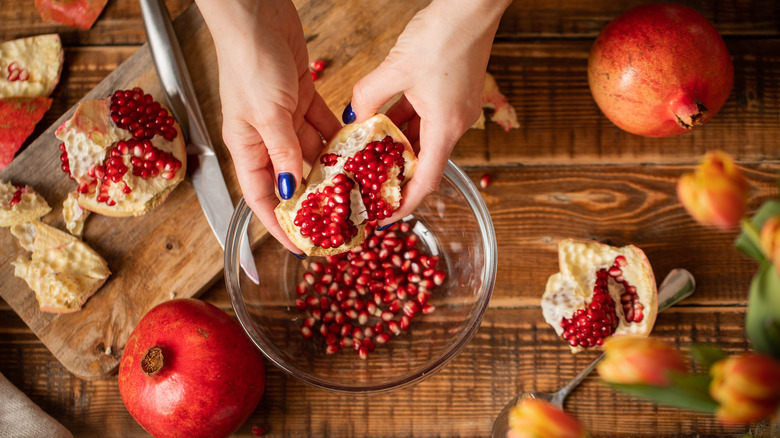How To Choose The Tastiest Pomegranate At The Store
As crispy autumn air replaces sultry summer days, supermarket produce evolves: Here come the earthy orange pumpkins, sweet potatoes, butternut squashes, and a host of root veggies. Then there are the enigmatic little red round fruits called pomegranates, scientifically known as Punica granatum. Devotees of this seedy, nutrient-packed fruit eagerly await the end of September, when they roll into produce aisles in all their crimson glory.
With such colorful, thick cloaks guarding curious clans of juicy seeds, choosing the tastiest pomegranate is no small feat. But it's not entirely a guessing game. Like any other fruit, a few secret insights can land a luscious burst of tarty, flavorful goodness on your tastebuds. Within minutes of peeling back the skin, you'll know whether your fruit-whispering instincts were right.
The road to pomegranate-picking expertise starts with discerning these simple attributes: vibrant red skin, blemish-free smoothness, and a firm rather than soft exterior. You also should pay attention to its size and weight, which can indicate proper ripening and full juiciness of the edible insides. Compare the dimensions to a large orange, but much heavier than expected. If it's too small or too light, the exquisite, juicy inner seeds may be bland and dry due to being picked before the pomegranate is fully ripe.
Look and touch to achieve pomegranate perfection
When popping those precious seeds directly into your mouth or extracting the liquid for a chilled glass of fresh pomegranate juice, the ideal fruit produces a bold taste with a balance of sweet and tart flavors. All that goodness comes from the roughly 600 seeds tucked beneath the skin, which bear the same brilliantly hued ruby-red coloration as the exterior.
The tiny red seeds are covered by semi-transparent, edible arils containing the prized tangy-sweet juice, making each little morsel plump and shiny. However, these attributes aren't visible when choosing which pomegranate to grace your kitchen counter or picnic basket. Therefore, when selecting, you'll conduct a visual and touch-based taste test from the outside.
Choose a pomegranate that's roughly 2 ½ to 5 inches wide and relatively heavy. This indicates ripeness as the seeded arils fill with flavorful juice. As each aril expands, it pushes against the exterior skin, making it firm and taut. This can also slightly change the round shape, creating flat, square-like areas. When choosing, gently press the pomegranates and opt for ones that give a bit of resistance, avoiding any that feel light or pliable. Also, always look for vibrant colors over paler ones.
Pomegranate seeds boast nutritious goodness
Choosing the tastiest pomegranate at a store is about more than refreshing flavor. Those round beauties happen to cradle all kinds of nutritional goodness when they're ripe and ready. According to Healthline, when consumed in its natural seed form — rather than as a juiced liquid — you'll get a substantial dose of fiber, vitamin C, folate, magnesium, and other vitamins and minerals.
Even more significant are the powerful antioxidants in pomegranates, which can thwart cell damage caused by free radicals, thereby protecting from various chronic diseases. Pomegranates also potentially help with inflammation, heart health, endurance during exercise, cancer prevention, and brain and digestive health.
After selecting the ultimate pomegranate for your health and enjoyment, feel free to snag several more. In an unpeeled state, they'll last up to two weeks in shady room temperatures, which expands to two months when whole and refrigerated. You'll miss these perky little treats when the season ends in January or February, but no worries: Scoop out the seeds and freeze them for up to a year.



